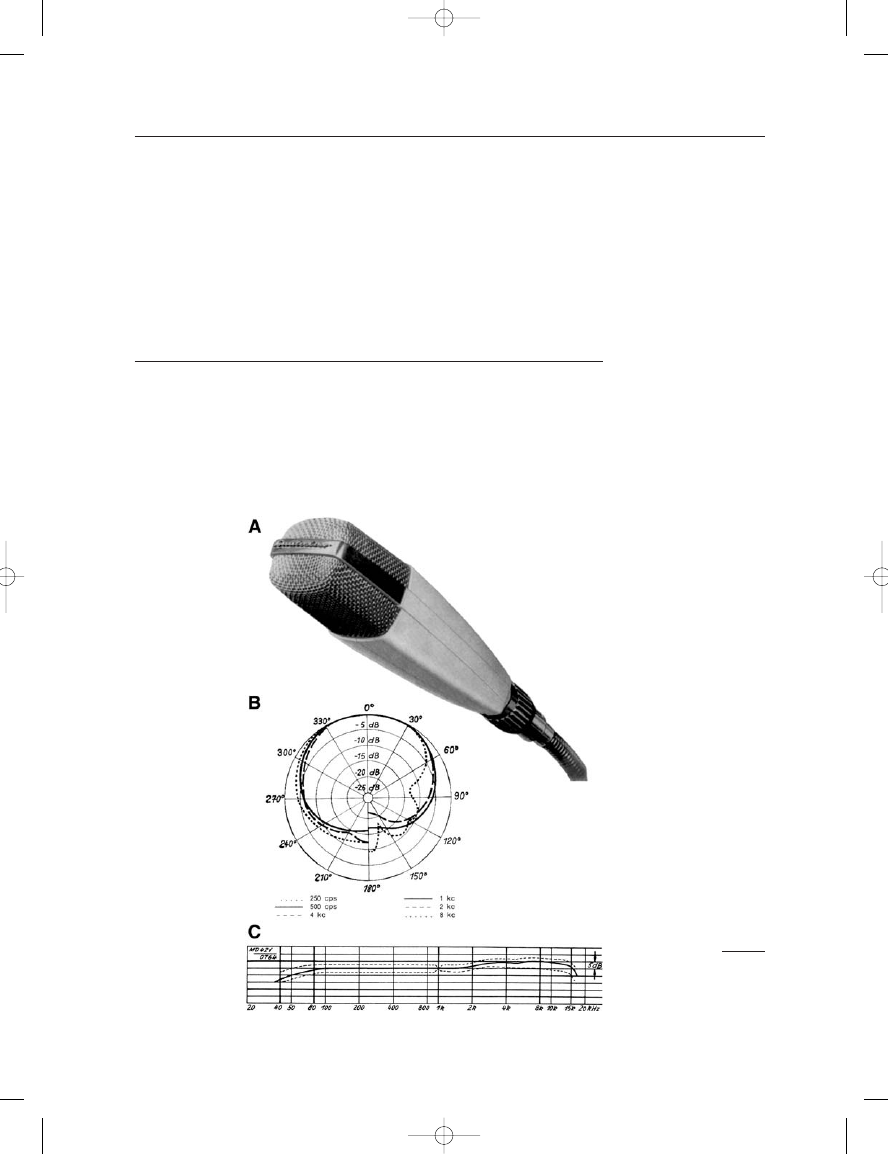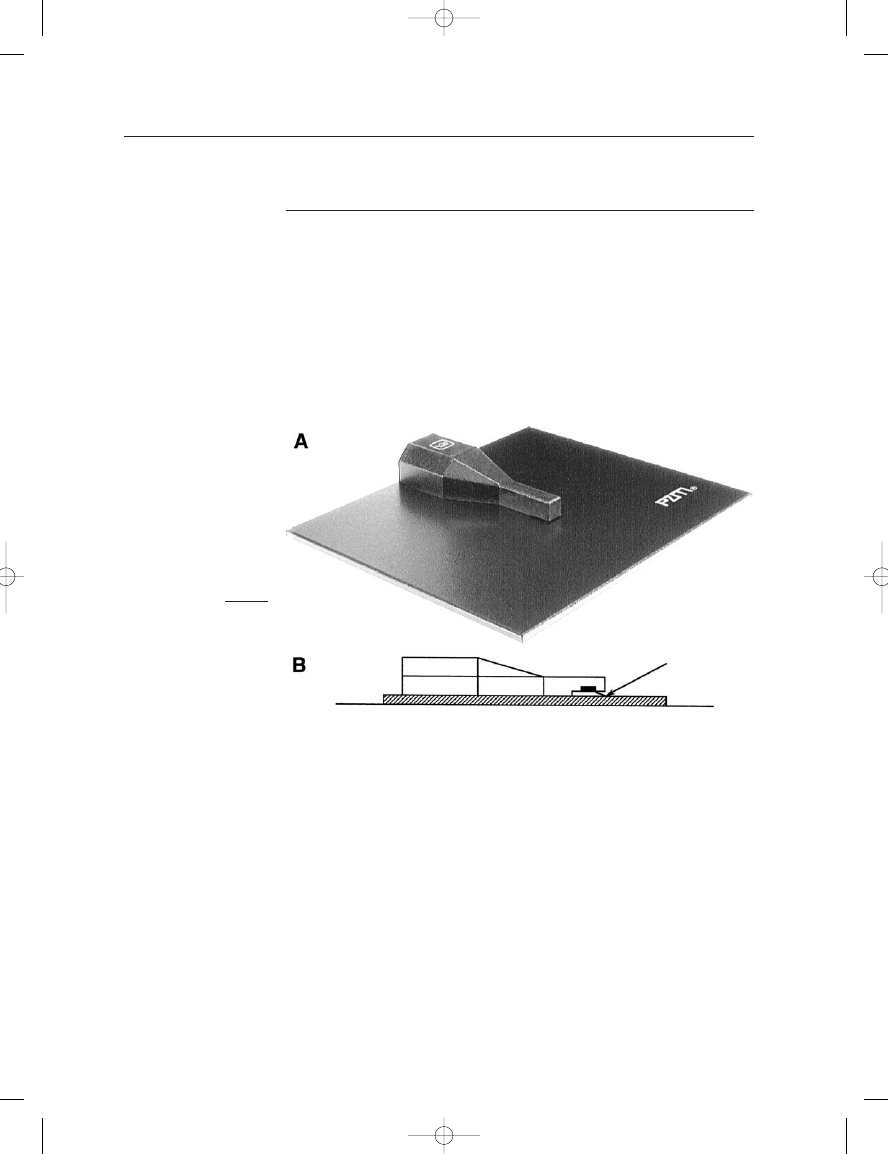ВУЗ: Казахская Национальная Академия Искусств им. Т. Жургенова
Категория: Книга
Дисциплина: Не указана
Добавлен: 03.02.2019
Просмотров: 17452
Скачиваний: 51

21: Classic Microphones: The Author’s View
363
(0.6–0.7 in). Many of these had families of replaceable capsules that
could operate on a common preamplifier. Figure 21–26 shows three such
early models, one from each company, that typified this design approach.
With the advent of phantom powering in the 1960s these designs prolif-
erated and, with their lower prices, eventually dominated the profes-
sional market, at least in terms of numbers.
SENNHEISER MODEL MKH 404 RF MICROPHONE
Taking advantage of solid state electronic components and remote
powering, Sennheiser Electronics introduced its RF microphones in the
early 1960s. The designs have been refined over the years, and today they
are the flagship products of the company, exhibiting performance
characteristics that are at the leading edge of the art. The MKH 404,
shown at Figure 21–27A, was the first solid state cardioid microphone
FIGURE 21–27
Sennheiser MKH 404 RF
microphone: photo of
microphone (A); polar
response (B); off-axis
response curves (C);
circuit diagram (D). (Data
courtesy of Sennheiser
Electronics and Tremaine,
1969.)
Earg_21.qxd 14/9/04 3:09 PM Page 363

that operated on the RF principle. The design had been preceded by the
omnidirectional model MKH 104. Performance data is shown at B and C,
and a schematic drawing of the electronics is shown at D. The overall
uniformity of response is notable, but the polar response is exemplary,
even by today’s standards. In the earliest days of these models, phantom
powering was not yet in general use; Sennheiser manufactured an in-line
battery module that provided 9 Vdc powering for these microphones.
SENNHEISER MODEL MD 421 DYNAMIC
MICROPHONE
The famous 421 was introduced in 1960 and has been in the Sennheiser
catalog ever since. While it was intended as a general-purpose dynamic
cardioid, its robustness was evident from the start. It eventually gravi-
tated, along with the AKG D-12, into its present role as a kick drum
microphone par excellence. Today it is the most sought-after dynamic
microphone for that purpose.
THE MICROPHONE BOOK
364
FIGURE 21–28
Sennheiser Model MD 421
dynamic. (Data courtesy of
Sennheiser Electronics.)
Earg_21.qxd 14/9/04 3:09 PM Page 364

CROWN INTERNATIONAL MODEL PZM-30
BOUNDARY LAYER MICROPHONE
Dating from the early 1970s, this is the “youngest” microphone presented
in this survey. The Crown PZM pressure zone microphones differ from
other omni boundary microphones in that they provide a short indirect
path to the microphone capsule, thus ensuring that the amplitude pickup
will not be materially influenced by the bearing angle of the sound source.
The microphone is shown in Figure 21–29A, and details of the actual
path to the capsule are shown at B. The PZM-30 has been in the Crown
catalog since it was introduced and remains the classic reference for
boundary layer recording.
21: Classic Microphones: The Author’s View
365
FIGURE 21–29
Crown International
PZM-30 boundary layer
microphone: photo (A);
detail of sound pickup (B).
(Photo courtesy of Crown
International.)
Earg_21.qxd 14/9/04 3:09 PM Page 365

Earg_21.qxd 14/9/04 3:09 PM Page 366

REFERENCES AND
BIBLIOGRAPHY
GENERAL AND HISTORICAL
L. Abaggnaro, ed., AES Anthology, Microphones. New York: Audio Engineering
Society, 1979.
Anon., “The Telephone at the Paris Opera.” Scientific American, 31 December
1881 (reprinted in Journal of the Audio Engineering Society 29, no. 5 (May
1981).
M. Barron, “The Subjective Effects of First Reflections in Concert Halls – the
Need for Lateral Reflections.” Journal of Sound and Vibration 15 (1971),
pp. 475–494.
B. Bauer, “Uniphase Unidirectional Microphone.” Journal of the Acoustical
Society of America 13 (1941), p. 41.
B. Bauer, “A Century of Microphones.” Proceedings, IRE (1962), pp. 719–729
(Also, Journal of the Audio Engineering Society 35, no. 4 (1987).
A. Benade, Fundamentals of Musical Acoustics. New York: Oxford University
Press (1976).
L. Beranek, Acoustics. New York: J. Wiley, 1954.
L. Beranek, Concert and Opera Halls: How they Sound. Acoustical Society of
America, New York (1996).
W. Bevan et al., “Design of a Studio Quality Condenser Microphone Using
Electret Technology,” Journal of the Audio Engineering Society 26, no. 12
(1978). (Included in AES Microphone Anthology.)
J. Blauert, Spatial Hearing. Cambridge, MA: MIT Press, 1983, pp. 209–210.
G. Boré, Microphones. Neumann USA, Sennheiser Electronics, 6 Vista Drive,
Old Lyme, CT, 06371 (1989).
M. Brandstein and D. Ward (eds), Microphone Arrays, New York: Springer,
2001.
H. Braünmuhl and W. Weber, “Kapacitive Richtmikrophon,” Hochfrequenztechnic
und Elektroakustic 46 (1935), p. 187.
D. Cooper and T. Shiga, “Discrete-Matrix Multichannel Sound,” Journal of the
Audio Engineering Society 20, no. 5 (June 1972).
J. Cooper, Building a Recording Studio, 5th edn. Synergy Group, 23930
Craftsman Road, Calabasas, CA 91302 (1996).
Earg_Ref.qxd 14/9/04 3:13 PM Page 367